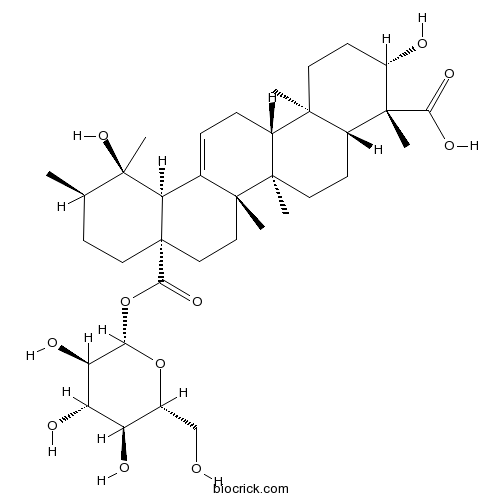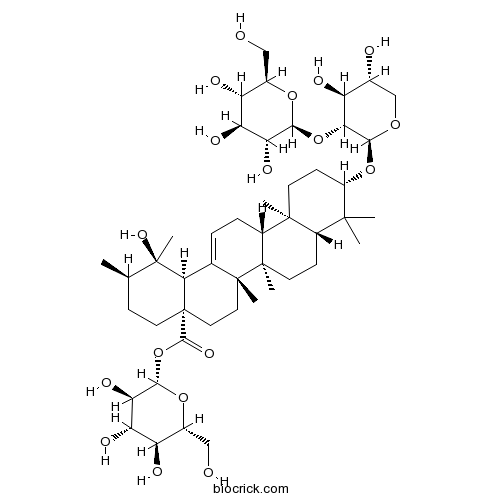Ilex pubescens
Ilex pubescens
1. The products in our compound library are selected from thousands of unique natural products; 2. It has the characteristics of diverse structure, diverse sources and wide coverage of activities; 3. Provide information on the activity of products from major journals, patents and research reports around the world, providing theoretical direction and research basis for further research and screening; 4. Free combination according to the type, source, target and disease of natural product; 5. The compound powder is placed in a covered tube and then discharged into a 10 x 10 cryostat; 6. Transport in ice pack or dry ice pack. Please store it at -20 °C as soon as possible after receiving the product, and use it as soon as possible after opening.

Natural products/compounds from Ilex pubescens
- Cat.No. Product Name CAS Number COA
-
BCN7867
Ilexsaponin A108524-93-2
Instructions

-
BCN7866
Ilexoside K109008-26-6
Instructions

-
BCN7865
Ilexoside D109008-27-7
Instructions

-
BCN7863
Ilexhainanoside D1137648-52-2
Instructions

-
BCN6148
Taraxerol127-22-0
Instructions

-
BCN1253
Homovanillic acid306-08-1
Instructions

-
BCN5246
Oleuropein32619-42-4
Instructions

-
BCN5590
Daidzein486-66-8
Instructions

-
BCN5616
Oleanolic acid508-02-1
Instructions

-
BCN2396
Genistin529-59-9
Instructions

-
BCN4477
Umbelliferone93-35-6
Instructions

Two new secoiridoid glucosides and a new lignan from the roots of Ilex pubescens.[Pubmed: 30046967]
Two new secoiridoid glucosides, ilexpublignoside (1), pubzenoside (2), and a new lignan, ilexlignan B (3), along with seven known compounds (4-10) were isolated from the roots of Ilex pubescens for the first time. Their chemical structures were elucidated on the basis of extensive spectroscopic methods, including IR, UV, HR-ESI-MS, CD, NMR experiments, as well as comparison with the reported data.
An integrated strategy for rapid discovery and identification of quality markers in Guanxin Kangtai preparation using UHPLC-TOF/MS and multivariate statistical analysis.[Pubmed: 29551647]
Guanxin Kangtai preparation (GXKT), consisting of Panax ginseng, Panax notoginseng and Ilex pubescens, is a new proprietary Chinese medicines under development for treating coronary heart disease. Like other Chinese medicines, the components of GXKT were complex and the bioactive compounds remained unclear.
Pro-angiogenic effects of Ilexsaponin A1 on human umbilical vein endothelial cells in vitro and zebrafish in vivo.[Pubmed: 29157819]
Ilexsaponin A1 is the major bioactive ingredient of Ilex pubescens Hook. et Arn. This plant has been conventionally used in Traditional Chinese Medicine for the treatment of cardiovascular diseases including stroke, coronary arterial disease, and peripheral vascular diseases.
Neuroprotective effect of total flavonoids from Ilex pubescens against focal cerebral ischemia/reperfusion injury in rats.[Pubmed: 28944915]
Ilex pubescens is commonly used in traditional Chinese medicine to treat cardiovascular and cerebrovascular diseases, such as coronary artery disease and stroke. However, the underlying mechanisms remain to be fully elucidated. The aim of the present study was to investigate the effects of Ilex pubescens total flavonoids (IPTF) on neuroprotection and the potential mechanisms in a rat model of focal cerebral ischemia/reperfusion (I/R) injury. Rats were pretreated with intragastric administration of IPTF at doses of 200 and 100 mg/kg for 5 days; middle cerebral artery occlusion surgery was then performed to induce cerebral I/R injury. Neurological deficits were determined using the 5‑point neurological function score evaluation system, brain infarct sizes were determined by 2,3,5‑triphenyltetrazolium chloride staining and alterations in brain histology were determined by hematoxylin and eosin staining. The neurological deficit score, the infarcted area and the brain tissue pathological injury were significantly reduced when the rats were pretreated with IPTF. In addition, inflammatory mediators and neurotrophic factors in the brain were investigated. IPTF pretreatment decreased the activities of total nitric oxide synthase (TNOS), induced NOS (iNOS) and constitutive NOS (cNOS), and the levels of nitric oxide (NO), interleukin‑1β (IL‑1β) and tumor necrosis factor‑α (TNF‑α), however, it increased the levels of IL‑10 in brain tissues. Furthermore, pretreatment with IPTF also increased the protein expressions of brain‑derived neurotrophic factor, glial cell‑derived neurotrophic factor and vascular endothelial growth factor, when compared with the model group. In conclusion, the results of the present study demonstrated that IPTF has a neuroprotective effect against focal cerebral I/R injury in rats. The mechanism may be associated with the decreased production of certain proinflammatory cytokines including NO, IL‑1β, TNF‑α, TNOS, iNOS and cNOS, the increased production of the anti‑inflammatory cytokine IL‑10 and the increased secretion of neurotrophic factors.
Simultaneous Qualitative and Quantitative Analyses of Triterpenoids in Ilex pubescens by Ultra-High-Performance Liquid Chromatography Coupled with Quadrupole Time-of-Flight Mass Spectrometry.[Pubmed: 28925005]
Ilex pubescens Hook et Arn mainly contains triterpenoids that possess antithrombotic, anti-inflammatory and analgesic effects. Quantitative and qualitative analyses of the triterpenoids in I. pubescens can be useful for determining the authenticity and quality of raw materials and guiding its clinical preparation.


